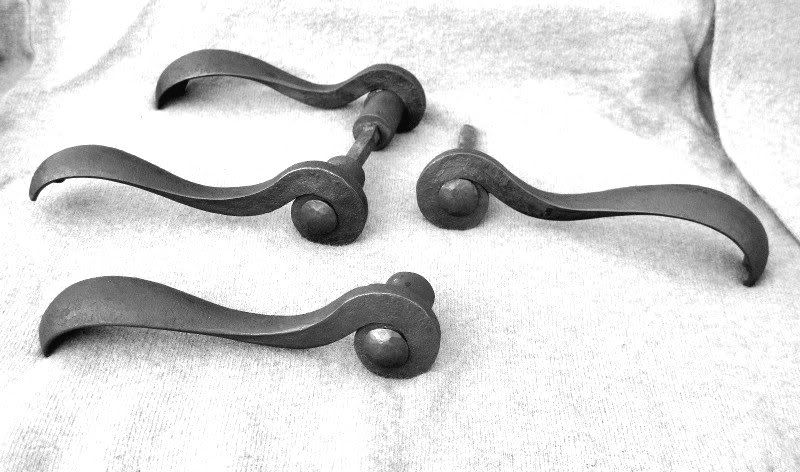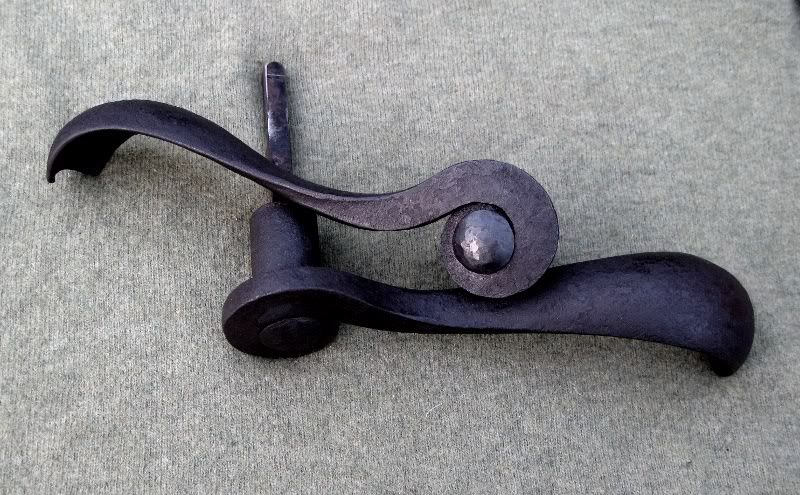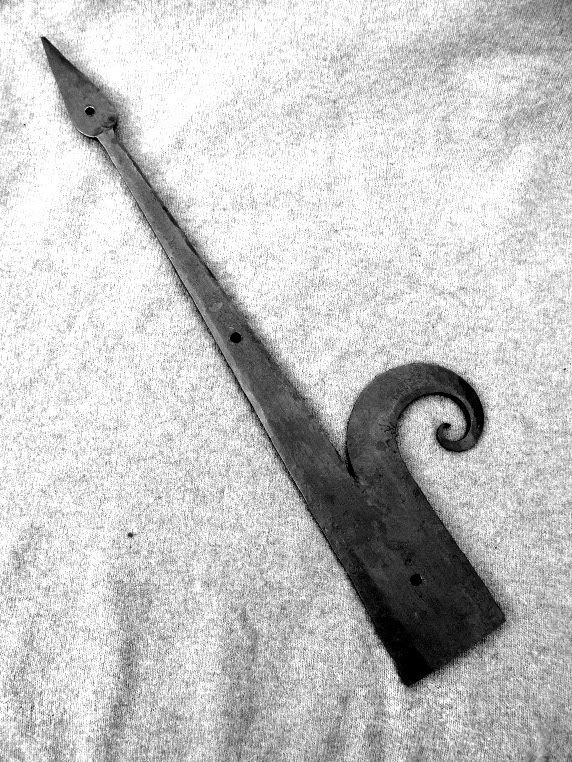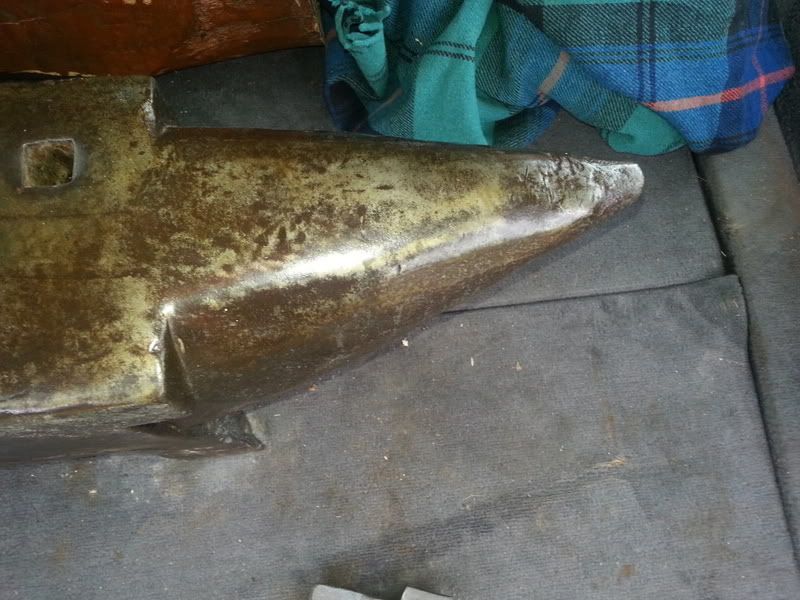
matei campan
-
Posts
405 -
Joined
-
Last visited
Content Type
Profiles
Forums
Articles
Gallery
Downloads
Events
Posts posted by matei campan
-
-
you can even make tools to insert in that holes
-
http://www.iforgeiron.com/topic/30256-what-is-this-for-an-anvil/
that's what I would like as a knifemaking anvil
or, this, below, would be the ideal - raised face to have left/right edges not so far from the anvil's sweet-point (not like the edge on the long heeled anvils), so very effective when you form the bevels.
look also at the japanese anvils, they make quiet fine cutlery on them...
-
I think, as I can see in the pictures, that the hammer is bolted to a large enough steel plate (?)
-
Mihai, you know, we wait for some video...
-
thank you, I'm glad you like them.
I made a round hole in the handle which, then, at yellow heat I squared it by punching a square piece of bar inside, the same kind which lately I used as shaft. then, one end is brazed to the handle. the other handle in the pair has a little hole pierced through it and shaft, which, lately will receive a little nail to prevent it from slipping out, but, at the same time to be removable at wish. -
recently I finished some door accessories - handles, shields, hinges (faux). here are some (many, It's hard to choose, so, forgive me) pics of them.











-
if you'll use a VFD, you won't have to over-complicate it mechanically, maybe something like engage/disengage "clutch" will suffice.
-
http://www.youtube.com/watch?v=B7Izy9a9m8k
http://www.youtube.com/watch?v=UqwxkyaSws8
is that fast enough what Murray Carter is using?
-
meantime, I've got used to the graphite fire and it seems to burn easier than the coke I was using, at least needs less air to keep burning, and the beauty of it is that you can burn it all day long, it doesn't get self suffocated by ash, clinkers, etc. the graphite "nuts" just seem to "evaporate", you can't find smaller pieces than, let's say, almost 1,5-2 centimeters in diameter... very interesting.
once you start the fire, you just add graphite and burn it as long as you need, it's maintenance free. I start it burning with a little charcoal fire, it starts easier than my coke.
the not so fine aspect of it it's the fact that I have to chop it down to usable size. another aspect is the toxicity fact mentioned previously - at the beginning there's a smell and some blue flames, but then, once it's burning right, there's little smell, lot less than coke. I don't if it's harmful or not... -
the interesting thing is that I'll buy an anvil like that. I've already mentioned that on this forum, an anvil like that would be a very good knifemaker's anvil, you have edges to work the blades's bevels. but's not only good for that, but for many other things. on a good anvil, especially on the very elongated and thin ones, it's more difficult to use the heel's edges. on the broken ones, you have an edge near to the sweet-point area, which makes it ideal. and if you just dress the breakage surface, you'll have something looking like a "colonial" anvil.
to repair such an anvil, it worths just for the fun of it.
If you already have a perfect anvil, consider this another tool, with different features. if you will repair it, you'll have just another anvil, but of less quality (?), with the time and $ invested in it enough to buy at least one other in good condition. -
that's interesting, I got aprox the same amount of old files (weight speaking) for free :)
-
having no time ( read "being to lazy") to build a proper stand for my blacksmithing wise, I just inserted the short leg in the hardy hole of a spare anvil which also need a stand :)
that leg wise is the most popular model around here and it has a short leg, it is not broken, that like that from birth. -
I really would like a broken one like yours for the knife making. I would dress the edge in the broken area and I'd get an even better anvil to forge down the blade's edges than a "normal" one.
-
this color thing reminds me what happened to a teacher of mine who used to have a ~100yrs(?) old lathe in his workshop, which was black (in fact mostly the old steel's patina). once there came a visitor who, looking at the lathe, asked my teacher what tool is that, and, my teacher asked that's a lathe. the visitor, amazed, said "but the lathes aren't green?". in fact almost all industrial equipment till recently was painted green in my country.
-
speaking of hammer acquisitions, I bought 4 ~2.5-3kg sledge heads quiet cheap and not so hard, which I transformed into drawing sledges. I had to make some damascus, and using usual one hand hammering (no PH yet...) is quiet slow, as you know and a real pain in the back. so, I've started to hold the steel bar to which the billet is welded between the legs and to hammer with the sledge two handed, and I have to say that's far better, maybe 3 times faster.
-
that things are evident, what I was thinking is that I was missing something about rebound and things like that, things which are not so evident, at least for me.
my forging hammers, especially the big ones for gross work, are on the medium-soft side for a hammer, not dead soft, but they don't mark the anvils I own, which are not quiet in the 60s HRC, though not too soft either, even that a hard hammer will mark most of them. by the other hand, they are not mushroomed yet, not obviously marked and once in a while I just have to dress them lightly. I don't use hammers in that state of damage that they leave unwanted marks on the work. -
yes, hammer control is paramount, but, once in a year, I misplace a blow, with all my control, and, usually, that's a heavy blow.
dressing a hammer takes no more than a couple of minutes, once in a couple of years, if it's necessary at all. and, in the end, a hammer is very easily replaceable. for hitting the tools, I understand the interest and I use hard hammers and I have ones dedicated for this, that's why I asked about those which work just on hot metal.
well not as soft as "dead soft", but softer than the anvil... -
in the beginning, I was looking for hard hammers to use in the forging, but after few missing blows and little dents in the anvil, I've started to favor softer hammers for forging (also, they are cheaper and easier to modify).
so are there any reasons for that the forging hammers (which touch just hot iron and, on occasion, the anvil) to be on the hard side rather than the soft side, and I miss them? -
thank you
there's not only a depression/deformed area, it's a mix of crumbled(?) and "peeling off" (displacement, as you say) of a hard layer (being it the normally hardened layer or work-hardened or both), and that's bothering me. if it would be just a deformation, I wouldn't bother too much. the "peeling" is present also on the square horn, but not too much.
as for the material, I don't know yet what is made of and how. it could be cast steel, but also other things. I bought it from France, it's a classic French anvil in very reasonable shape, generally, except that horns and minor chipping. it's a beauty (at least for me, who I am fond of French anvils), but I'm still waiting for her (why I just said "her"?)... I'll post some pictures of her naked, full body, when I'll get it.
the repair, if done, I want it both cosmetic and functional, so that's why I asked for alternatives to 312 stainless, as it will shine like silver. -
ok then, no pointy (cause I have other pointier anvils and less pointy as well, so it's not an issue), but, instead of dressing by removal, I'd prefer to add, as I said before. what other alternatives to 312 stainless rod would be (that being one option) other than mild steel?
-
that's true that I also use a lot mild steel tools, I even prefer the softer hammers for forging (so that they will take the abuse not the anvils). so, if the tip of the anvil is not as hard, this doesn't bother me much, but, again, if possible, and not a real pain, I would like it a bit harder (indenting resistant) than mild steel.
what bothers me the most is that crumbled area, where the hardened layer is broken and somewhat peeled away. I could just grind that and reshape, to smoothen the area, but I don't want to take from the hardened thickness, but rather add material.
and also, I don't want to spend more money on welding sticks than I spent on the anvil :) -
thanks
the edges, in fact, are just fine, I don't want them sharper and I already say it's not a must, just cosmetic, if the repairing it is ok. what I want to repair is just the tip of the rounded horn and a bit the square one. as for using every feature of an anvil and other bits of tools, I'm the master (just kidding, but not much). I work on everything. I also regret a worn out anvil, with a good amount of "dish" and other "interesting" features (but it was not mine), as I was able to do more work on it than if it was perfect. I was able to do work no one in the country was even consider to make and not know how to, (a lot of copper sheet ornaments) using a legwise in wich I used to fix a plough share, a pipe, a pipe "elbow", and a couple of iron bits. If someone would have seen the work, then the tools, would have been asking "but where are the tools"...
I still have a dished anvil with rounded corners, etc., and other anvils, each with different shapes and sizes (I'm starting to get spoiled, more anvils than I need, I've got the "anvil virus", you know..., but I just can't help myself)
so, I could use it as it is, but, if possible and not too complicated, I would like to fix it -
hi all
there is an anvil coming to me in near future, for the moment I just got some pics. here are pics of the two horns. especially the round one has the tip damaged, I would like to dress it (them) a bit, to add some material to it to be more pointy and resurface the damaged/crumbled area. I really use these areas (though not very heavy work). it seems that the hardening is quiet shallow, and, on some areas, like the tips of the horns, it was just knocked off. I don't know yet if it's a cast steel one or a forged one.
I think to weld a medium C piece to prolong that tip, then to resurface the damaged area, with, maybe, an overlap on the welded tip "addition".
so what kind of stick you would use?
I found some build up stick that's available locally that says it's shock abrasion resistant and will have a 51-57hrc after welding.
it's a rutille electrode with 0.6 %C, 1.1%Mn, 1.0% Si, 2.8% Cr
what do you think about that? is that OK? and how you'll proceed - preheating, which temperature, etc? and if it works, I would like to make also some minor repairs on the edges to fix some dings (not forcefully) , nothing massive as you can see in the pics:

-
the scrap graphite is cheaper than coke, but you have to break it down to usable size. the one i saw used in foundry, it came in really big chunks, it was broken down with sledges. Ill put some pictures of mine.



high speed cutlers power hammer project.
in Power Hammers, Treadle Hammers, Olivers
Posted
link removed becasue anvilfire does not want links posted